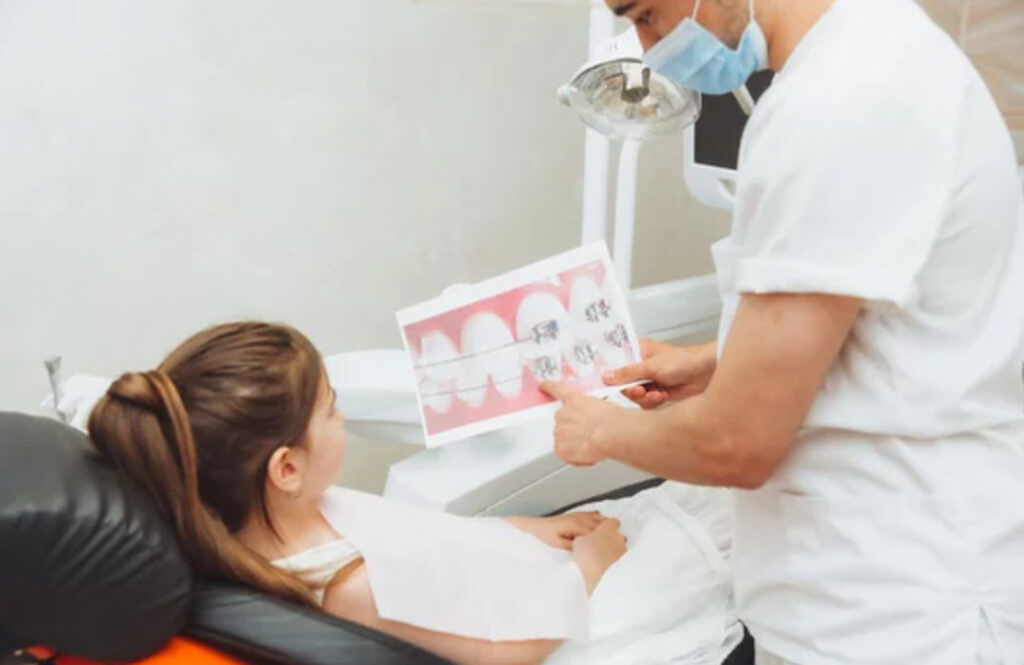
A staggering number of children and young teens should be getting braces for one reason or another and simply aren’t, because they aren’t seeing a dentist. This is a disturbing trend because not addressing oral hygiene issues and dental misalignments when they come up can lead to an increased prevalence of problems later. It can also result in a significant variety of diseases of the mouth.
This is part of the reason why it’s so important that braces be installed at the right point in a patient’s life. If they are installed too early, there may still be some significant dental movement that happens as the teeth settle into their final places. However, if taken on too late, the adjustments can be more difficult and can take more time. Finding the right time to get braces is a common concern for many parents and their children.
How Old Do You Have To Be To Get Braces?
The age range where most orthodontics are investigated is 7 to 12. While this may not be when the braces are put on, though they can be if needed, it’s generally the ideal time to begin seeing an orthodontist. The first appointment will often be used to check for a few things, such as jaw misalignment, and overcrowding, and will ask about breathing habits such as mouth-breathing or snoring. They will also generally get some imaging of the child’s teeth so that treatments can be planned and potential complications mapped.
Jaw misalignment can often be corrected with braces, by placing bands on the back teeth to keep the upper and lower jaws aligned. Overcrowding is where the teeth are too close together and are affecting the position and proper alignment of all the others. Sometimes overcrowding results in the need for tooth extraction, to give the remaining teeth more freedom of movement. Being a mouth-breather, thumb sucker, or snoring, may be indications of potential dental issues that may need to be addressed as well.
The short answer is that the earliest age that someone can get braces is when their adult teeth have begun to erupt, often around age 7. Any earlier than that and important information related to permanent teeth can be overlooked. The permanent teeth, particularly the molars, continue to erupt into their 20s, so the teeth will not find any permanent position until at least then.

How To Tell If Braces Are Needed
Knowing how to tell if your child needs braces is important since correcting issues early on can make it much easier. Identification of misalignment can also help determine which types of braces your child may be able to use, and how long they may need to wear the braces. Some potential misalignments can be easy to spot, while others are more difficult and require the examination of an orthodontist.
You may be able to tell if they have an overbite or an underbite, just by seeing them and looking at their jaw alignment. When they smile, you may also be able to spot other types of misalignments that could benefit from braces. Additional signs that braces may be needed include:
- Trouble breathing, such as mouth breathing
- Snoring during sleep
- Dark circles under the eyes from disrupted sleep
- Challenges with eating
- Crowded or gapped teeth
- Issues or difficulty with speech
- Teeth or jaws that are disproportionate to others
While none of these factors are automatic determining factors of needing orthodontic treatment, they are strong indicators. Even if you haven’t seen any of these signs, they may not be identifiable by a parent and may need a professional examination after age 7 to determine if further orthodontic monitoring is needed.

What Can Happen If They Don’t Get Braces That Are Needed?
Sometimes even though braces are needed, they aren’t obtained. Depending on the situation, this can result in symptoms as mild as simply having tooth or jaw pain from crowding during eating. If left unaddressed this pain can result in the need for surgery to remove broken or crowded teeth. The issues that the braces are needed to correct will inevitably become more serious, and can eventually lead to a crowded or gapped smile, and can even lead to permanent shifting of teeth positions.
Different Types Of Braces Commonly Used
Metal
Metal braces will feature metal brackets and wires, all generally made from stainless steel. Each tooth will have a bracket installed, and those brackets will clamp down on the archwire to hold it in place and force the gentle alignment of the teeth. Metal braces are generally the most common type for school-age children, and are also one of the more affordable types.
Metal braces come in two types. The primary type is the one you see more often, where the brackets are on the lip-side of the teeth, facing outward. The other type of metal braces are called lingual braces, and the difference with those is that the bracket is installed on the tongue side of the teeth. This goes a long way toward hiding the appearance of braces.
Ceramic
Ceramic braces look a lot like their metal counterparts, but they are more inconspicuous and easier to hide. The ceramic bracket material is created to either be clear or tooth-colored, which means they blend in with the mouth much easier. Braces can induce a lot of self-esteem and confidence issues in children in particular, and ceramic braces help minimize that effect.
Ceramic braces are ideal for parents and kids who don’t want to draw extra attention to their teeth during the term of the treatment. There is a compromise to be made with ceramic braces, however, and that compromise comes in the price and material capabilities. Ceramic braces are often more costly than metal, and since they are less durable overall, teeth move slower because adjustments are finer.
Clear Aligners
Clear aligners are small, clear trays that are modeled after your teeth, and are used in a specific sequence to realign your teeth. One of the most popular and well-known brands of clear aligners is Invisalign, but there are many others, and they all function relatively the same.
The patient does an initial consultation and is sent a kit to make an impression mold of their teeth. They make a mold, take some pictures, and send them back to the company, which then analyzes them. The molds are 3D scanned and there are then generally 20 clear trays that are made to align the teeth. They can be painful in some cases since the adjustments can be more severe than with conventional braces.

How Are Braces Installed?
If braces are needed, one of the most anxiety-inducing things is getting them put on, and not knowing what to expect. While each dentist or orthodontist will have their own process, in most cases it will look like the following.
Preparation Spacers
In some cases, the back teeth will need some additional spacing between them before the braces are installed. If this applies to your installation, the dentist will install rubber spacers on the teeth a week or two before the installation. This makes sure there is enough space to attach the bands around the back teeth. Usually, this will result in some mild soreness.
Initial Cleaning
Before braces can be attached to your teeth, they will need to be cleaned. Once they have been thoroughly cleaned the installation can start.
Affixing The Brackets
The brackets are the small metal or ceramic clamps that are glued to each tooth that will attach to the wire. The orthodontist will put a small dot of glue on each tooth and will place a bracket on each dot, then a blue or UV light will be used to help the cement set. The adhesive will have a bad taste, but it’s non-toxic.

Attaching The Bands
The braces are anchored by metal bands or sleeves that fit around each of the back teeth. These bands will also need to be cemented in place, so there will be another application of the glue and the curing light. These are one of the more uncomfortable parts of the installation, where the patient can experience a lot of twisting and pressure.
Attaching The Archwires
Once the bands and brackets are in place, it’s time for the orthodontist to attach the wires. These wires are held in the brackets by a small elastic band that clamps the bracket closed around the wire. In most cases, there will be several color choices for the elastic bands.
Properly Maintain Your Oral Health With Dental Essentials
Orthodontic treatment isn’t simply cosmetic changes to get better school pictures, it’s correcting sometimes severe misalignments of the teeth that can cause significant effects on speech, breathing, and eating. Recognizing the signs that orthodontic treatment may be needed is a critical factor in getting the right treatment at the right time. To help maintain better oral health in the time between visits to the dentist, keep your smile healthy with all of your dental essentials and whitening products at Dr. Brite.

